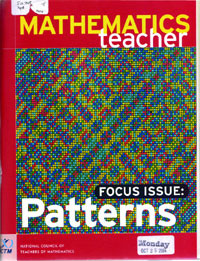The Kaprekar routine is an algorithm discovered in 1949 by D. R. Kaprekar for 4-digit numbers, but which can be generalized to -digit numbers. To apply the Kaprekar routine to a number
, arrange the digits in descending (
) and ascending (
) order. Now compute
(discarding any initial 0s) and iterate, where
is sometimes called the Kaprekar
function. The algorithm reaches 0 (a degenerate case), a constant, or a cycle, depending
on the number of digits in
and the value of
. The list of values is sometimes called a Kaprekar sequence,
and the result
is sometimes called a Kaprekar number (Deutsch and Goldman 2004), though this nomenclature
should be deprecated because of confusing with the distinct sort of Kaprekar
number.
In base-10, the numbers for which
are given by 495, 6174, 549945, 631764, ... (OEIS A099009). Similarly, the numbers
for which iterating
gives a cycle of length
are given by 53955, 59994, 61974, 62964, 63954, 71973,
... (OEIS A099010).
Iterating the Kaprekar map in base-10, all 1- and 2-digit numbers give 0. Exactly 60 3-digit numbers, namely 100, 101, 110, 111, 112, 121, 122, 211, 212, 221, ... (OEIS A090429), reach 0, while the rest give 495 in at most 6 iterations. Exactly 77 4-digit numbers, namely 1000, 1011, 1101, 1110, 1111, 1112, 1121, 1211, ... (OEIS A069746), reach 0, while the remainder give 6174 in at most 8 iterations. The value 6174 is sometimes known as Kaprekar's constant (Deutsch and Goldman 2004). This pattern breaks down for 5-digit numbers, which may converge to 0 or one of the 10 constants 53955, 59994, 61974, 62964, 63954, 71973, 74943, 75933, 82962, 83952.
The following table summarizes the possible cycles in various bases and the first few numbers of digits.
| possible cycles for | |
| 2 | 0,
0, 9, 21, |
| 3 | 0, 0, (32, 52), 184, (320, 580, 484), ... |
| 4 | 0,
30, |
| 5 | 8, (48, 72), 392, (1992, 2616, 2856, 2232), (7488, 10712, 9992, 13736, 11432), ... |
| 6 | 0, 105, (430, 890, 920, 675, 860, 705), |
| 7 | 0, (144, 192), (1068, 1752, 1836), (9936, 15072, 13680, 13008, 10608), (55500, 89112, 91800, 72012, 91212, 77388), ... |
| 8 | 21, 252, |
| 9 | (16,
48), (320, 400), |
| 10 | 0,
495, 6174, |

The figure above (similar to that appearing on the cover of the above issue of The Mathematics Teacher) shows the number of steps required for the Kaprekar routine
to reach a fixed point for values of to 9999, partitioned into rows of length 100 (Deutsch and
Goldman 2004). In this plot, numbers having fewer than 4 digits are padded with leading
0s, thus resulting in all values converging to 6174.